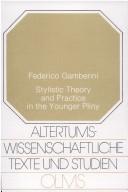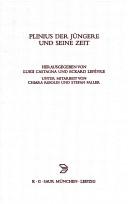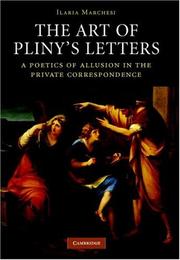| Listing 1 - 10 of 19 | << page >> |
Sort by
|
Book
Year: 1921 Publisher: Jena : Diederichs,
Abstract | Keywords | Export | Availability | Bookmark
 Loading...
Loading...Choose an application
- Reference Manager
- EndNote
- RefWorks (Direct export to RefWorks)
Book
ISBN: 9780521187275 9781107006898 0521187273 1107006899 Year: 2013 Publisher: Cambridge Cambridge university press
Abstract | Keywords | Export | Availability | Bookmark
 Loading...
Loading...Choose an application
- Reference Manager
- EndNote
- RefWorks (Direct export to RefWorks)
Pliny, --- Gaius Plinius Secundus Minor --- C. Plini Caecili Secundi --- Pline le Jeune --- Plinius de jongere --- Plinius der Jüngere --- Caius Plinius, --- Gaĭ T︠S︡et︠s︡iliĭ Pliniĭ Sekund, --- Gaj Plinije, --- Kaĭ Pliniĭ T︠S︡et︠s︡iliĭ Vtoroĭ --- Pline, --- Pliniĭ, --- Plinio, --- Plinius Caecilius Secundus, C. --- Plinius Caecilius Secundus, Caius --- Plinius, Caius, --- Plinius Caecilius Secundus, Gaius --- Pliny, - the Younger - Correspondence --- Pliny, - the Younger
Book
ISBN: 9782807610781 2807610781 Year: 2019 Publisher: Bruxelles, Belgium Peter Lang
Abstract | Keywords | Export | Availability | Bookmark
 Loading...
Loading...Choose an application
- Reference Manager
- EndNote
- RefWorks (Direct export to RefWorks)
Quelle importance les Romains accordaient-ils à la présence de l’eau, et jusqu’à quel point celle-ci jouait-elle un rôle dans leur vie quotidienne ? C’est à ces questions que répond cet ouvrage, en s’appuyant sur l’exemple offert par Pline le Jeune, qui écrivit sous le règne de Trajan, une période particulièrement brillante pour la civilisation romaine. Haut fonctionnaire, il fut chargé de résoudre bien des problèmes liés à la gestion de l’eau au cours de sa carrière, en même temps qu’il se délassait en jouissant de la présence de l’eau, aussi bien dans la nature que dans ses splendides piscines et salles de bain. En analysant en profondeur les passages de son œuvre où l’eau est mentionnée, que ce soit dans la description de paysages, rendus agréables grâce aux lacs et aux sources, dans la présentation d’un Empire à échelle mondiale s’appuyant sur la circulation sur eau des personnes et des marchandises, ou enfin dans l’évocation souvent très précise de techniques venues de l’hydraulique pour mettre l’eau au service des besoins et des plaisirs des hommes, ce livre se propose d’offrir à notre époque, pour laquelle l’eau devient de plus en plus un enjeu géostratégique, un point de comparaison et une matière à réflexion sur les permanences et les changements depuis vingt siècles. Que peut nous apprendre un Romain des années 100 de notre ère sur les usages de l’eau et ses représentations dans l’imaginaire collectif ?
Water in literature --- Pliny, --- Caius Plinius, --- Gaĭ T︠S︡et︠s︡iliĭ Pliniĭ Sekund, --- Gaj Plinije, --- Kaĭ Pliniĭ T︠S︡et︠s︡iliĭ Vtoroĭ --- Pline, --- Pliniĭ, --- Plinio, --- Plinius Caecilius Secundus, C. --- Plinius Caecilius Secundus, Caius --- Plinius, Caius, --- Criticism and interpretation. --- Gaius Plinius Secundus Minor --- C. Plini Caecili Secundi --- Pline le Jeune --- Plinius de jongere --- Plinius der Jüngere --- Plinius Caecilius Secundus, Gaius
Book
ISBN: 9780415705462 0415705460 9781032225418 1032225416 1003273025 1000557189 1003273025 Year: 2022 Publisher: Abingdon, Oxon ; New York, NY : Routledge,
Abstract | Keywords | Export | Availability | Bookmark
 Loading...
Loading...Choose an application
- Reference Manager
- EndNote
- RefWorks (Direct export to RefWorks)
"Pliny and the Eruption of Vesuvius is a forensic examination of two of the most famous letters from the ancient Mediterranean world, Pliny the Younger's Epistulae 6.16 and 6.20, which offer a contemporary account of the eruption of Vesuvius in 79 AD. These letters, sent to the historian Tacitus, provide accounts by Pliny the Younger about what happened when Mt Vesuvius exploded, destroying the surrounding towns and countryside, including Pompeii and Herculaneum, and killing his uncle, Pliny the Elder. This volume provides the first comprehensive full-length treatment of these documents, contextualized by evidence-rich biographies for both Plinys, and a synthesis of the latest archaeological and volcanological research which answers questions about the eruption date. A new collation of sources results in a detailed manuscript tradition and an authoritative Latin text, while commentaries on each letter offer copiously referenced insights on their structure, style, and meaning. Pliny and the Eruption of Vesuvius offers a thorough companion to these letters, and to the eruption, which will be of interest not only to those working on Vesuvius, Pompeii and Herculaneum, and the works of Pliny, but also to general readers, Latin students, and scholars of the Roman world more broadly"--
Pliny, --- Vesuvius (Italy) --- Eruption, 79. --- Plinius Caecilius Secundus, Gaius --- Gaius Plinius Secundus Minor --- C. Plini Caecili Secundi --- Pline le Jeune --- Plinius de jongere --- Plinius der Jüngere --- Caius Plinius, --- Gaĭ T︠S︡et︠s︡iliĭ Pliniĭ Sekund, --- Gaj Plinije, --- Kaĭ Pliniĭ T︠S︡et︠s︡iliĭ Vtoroĭ --- Pline, --- Pliniĭ, --- Plinio, --- Plinius Caecilius Secundus, C. --- Plinius Caecilius Secundus, Caius --- Plinius, Caius, --- Correspondence.
Book
ISBN: 2731406178 2821853181 Year: 2008 Publisher: Presses universitaires d’Aix-Marseille
Abstract | Keywords | Export | Availability | Bookmark
 Loading...
Loading...Choose an application
- Reference Manager
- EndNote
- RefWorks (Direct export to RefWorks)
Languages & Literatures --- Greek & Latin Languages & Literatures --- Pliny, --- Rome --- Politics and government. --- History --- Gaius Plinius Secundus Minor --- C. Plini Caecili Secundi --- Pline le Jeune --- Plinius de jongere --- Plinius der Jüngere --- Caius Plinius, --- Gaĭ T︠S︡et︠s︡iliĭ Pliniĭ Sekund, --- Gaj Plinije, --- Kaĭ Pliniĭ T︠S︡et︠s︡iliĭ Vtoroĭ --- Pline, --- Pliniĭ, --- Plinio, --- Plinius Caecilius Secundus, C. --- Plinius Caecilius Secundus, Caius --- Plinius, Caius, --- Plinius Caecilius Secundus, Gaius --- biographie --- correspondance (littérature) --- gouvernement --- droit antique
Book
ISBN: 9783110208740 3110208741 9786612716737 1282716735 3110217260 9783110217261 Year: 2009 Volume: 269 Publisher: Berlin de Gruyter
Abstract | Keywords | Export | Availability | Bookmark
 Loading...
Loading...Choose an application
- Reference Manager
- EndNote
- RefWorks (Direct export to RefWorks)
Die Untersuchung bemüht sich, die im allgemeinen vernachlässigte künstlerische Form der Briefe des jüngeren Plinius herauszustellen. Behandelt werden folgende Themen: Exempla antiquitatis (Würdigungen großer Männer, die noch die alte Zeit verkörpern und für Plinius vorbildhaft sind: Verginius Rufus, Titius Aristo, Antoninus Arrianus, Cornutus Tertullus), Verfall der individuellen Freiheit nicht nur unter Domitian, sondern auch unter Trajan, des Senats und der Redekunst der Gegenwart, bedeutende Schriftsteller in Vergangenheit und Gegenwart (Cicero, Plinius der Ältere, Silius Italicus, Martial), humanitas im Umgang mit anderen (sowohl mit anderen Völkern als auch mit Frauen und Sklaven), schließlich die Villa als geistiger Lebensraum und die Rezeption der Landschaft. Plinius spricht jeweils aus einem dezidiert eigenen Blickwinkel heraus. Auf diese Weise ergibt sich ein Gesamtbild seiner geistigen Persönlichkeit sowie der kulturellen Bedingungen der Epoche, da das Einverständnis der Adressaten aus dem Senatorenstand vorauszusetzen ist.
Pliny, --- Plinius Caecilius Secundus, Gaius --- Aesthetics. --- Authors, Latin --- Correspondence --- History and criticism. --- Caius Plinius, --- Gaĭ T︠S︡et︠s︡iliĭ Pliniĭ Sekund, --- Gaj Plinije, --- Kaĭ Pliniĭ T︠S︡et︠s︡iliĭ Vtoroĭ --- Pline, --- Pliniĭ, --- Plinio, --- Plinius Caecilius Secundus, C. --- Plinius Caecilius Secundus, Caius --- Plinius, Caius, --- Gaius Plinius Secundus Minor --- C. Plini Caecili Secundi --- Pline le Jeune --- Plinius de jongere --- Plinius der Jüngere --- Ancient History. --- Classical Archaeology. --- Classical Philology. --- Pliny the Younger.
Book
ISBN: 8884537983 8884537975 Year: 2008 Publisher: Firenze : Firenze University Press,
Abstract | Keywords | Export | Availability | Bookmark
 Loading...
Loading...Choose an application
- Reference Manager
- EndNote
- RefWorks (Direct export to RefWorks)
Esistenza minima brings together the results of a study carried out by the author in connection with his degree thesis. A celebrated pre-text – the letter of Pliny the Younger to Gallus in which he describes the Laurentian villa – becomes the mesh into which he weaves the pivotal figures of modernity. The continual cross-referencing of word and drawing, word and image, builds into a procedural approach that clearly posits the design dimension as the cognitive foundation. It is a singular, somewhat unusual text that transports the reader into a territory where the common ground between narration and memoir, the work of the masters and the personal diary, is intriguingly explored.
Architecture --- Philosophy. --- Pliny, --- Homes and haunts. --- Laurentine Villa (Laurentum) --- Gaius Plinius Secundus Minor --- C. Plini Caecili Secundi --- Pline le Jeune --- Plinius de jongere --- Plinius der Jüngere --- Caius Plinius, --- Gaĭ T︠S︡et︠s︡iliĭ Pliniĭ Sekund, --- Gaj Plinije, --- Kaĭ Pliniĭ T︠S︡et︠s︡iliĭ Vtoroĭ --- Pline, --- Pliniĭ, --- Plinio, --- Plinius Caecilius Secundus, C. --- Plinius Caecilius Secundus, Caius --- Plinius, Caius, --- Plinius Caecilius Secundus, Gaius --- Architettura --- Progettazione architettonica --- Disegno architettonico --- Plinio il giovane --- Franco Realla --- Adolfo Natalini

ISBN: 3487074486 9783487074481 Year: 1983 Volume: 11 Publisher: Hildesheim Olms
Abstract | Keywords | Export | Availability | Bookmark
 Loading...
Loading...Choose an application
- Reference Manager
- EndNote
- RefWorks (Direct export to RefWorks)
Pliny [Younger] --- Latin language --- Style --- Pliny, --- Literary style --- Rome --- Civilization --- -Classical languages --- Italic languages and dialects --- Classical philology --- Latin philology --- Pliny the Younger --- -Literary style --- Civilization. --- Style. --- Literary style. --- Rome (Italy) --- -Style --- Caius Plinius, --- Gaĭ T︠S︡et︠s︡iliĭ Pliniĭ Sekund, --- Gaj Plinije, --- Kaĭ Pliniĭ T︠S︡et︠s︡iliĭ Vtoroĭ --- Pline, --- Pliniĭ, --- Plinio, --- Plinius Caecilius Secundus, C. --- Plinius Caecilius Secundus, Caius --- Plinius, Caius, --- Gaius Plinius Secundus Minor --- C. Plini Caecili Secundi --- Pline le Jeune --- Plinius de jongere --- Plinius der Jüngere --- Plinius Caecilius Secundus, Gaius --- Latin language - Style --- Pliny, - the Younger - Literary style --- Rome - Civilization --- Pliny, - the Younger

ISBN: 3598777396 3111842703 3110959755 Year: 2003 Volume: 187 Publisher: München Saur
Abstract | Keywords | Export | Availability | Bookmark
 Loading...
Loading...Choose an application
- Reference Manager
- EndNote
- RefWorks (Direct export to RefWorks)
Der Band enthält 21 Beiträge deutscher und italienischer Gelehrter zu den Briefen und dem Panegyricus des jüngeren Plinius, die durch genaue Interpretationen versuchen, die Gedankenwelt dieses Repräsentanten an der Wende vom 1. zum 2. Jh. n. Chr. unter den verschiedensten Gesichtspunkten (Literatur, Rhetorik, Ästhetik, Gesellschaft, Wirtschaft, Politik und Rezeption) in das Denken der Römer seiner Zeit einzuordnen.
Pliny, --- Didactic literature, Latin --- Latin letters --- Letter writing, Latin --- History and criticism --- History --- Criticism and interpretation --- Rome --- Moral conditions --- Latin letter writing --- Latin literature --- Latin didactic literature --- Caius Plinius, --- Gaĭ T︠S︡et︠s︡iliĭ Pliniĭ Sekund, --- Gaj Plinije, --- Kaĭ Pliniĭ T︠S︡et︠s︡iliĭ Vtoroĭ --- Pline, --- Pliniĭ, --- Plinio, --- Plinius Caecilius Secundus, C. --- Plinius Caecilius Secundus, Caius --- Plinius, Caius, --- Rim --- Roman Empire --- Roman Republic (510-30 B.C.) --- Romi (Empire) --- Byzantine Empire --- Rome (Italy) --- Gaius Plinius Secundus Minor --- C. Plini Caecili Secundi --- Pline le Jeune --- Plinius de jongere --- Plinius der Jüngere --- Plinius Caecilius Secundus, Gaius

ISBN: 9780521882279 0521882273 9780511482298 9780521296977 0511387288 9780511388279 0511388276 9780511387289 0511482299 0521296978 1281254967 9786611254964 0511386257 0511384424 0511382618 Year: 2008 Publisher: Cambridge Cambridge university press
Abstract | Keywords | Export | Availability | Bookmark
 Loading...
Loading...Choose an application
- Reference Manager
- EndNote
- RefWorks (Direct export to RefWorks)
In this book on intertextuality in Pliny the Younger, Professor Marchesi invites an alternative reading of Pliny's collection of private epistles: the letters are examined as the product of an authorial strategy controlling both the rhetorical fabric of individual units and their arrangement in the collection. By inserting recognisable fragments of canonical authors into his epistles, Pliny imports into the still fluid practice of letter-writing the principles of composition and organisation that for his contemporaries characterised other writings as literature. Allusions become the occasion for a metapoetic dialogue, especially with the collection's privileged addressee, Tacitus. An active participant in the cultural politics of his time, Pliny entrusts to the letters his views on poetry, oratory and historiography. In defining a model of epistolography alternative to Cicero's and complementing those of Horace, Ovid and Seneca, he also successfully carves a niche for his work in the Roman literary canon.
Allusions in literature. --- Allusions dans la littérature --- Pliny, --- Criticism and interpretation. --- Correspondence --- Criticism, Textual. --- Allusions dans la littérature --- Allusions in literature --- Caius Plinius, --- Gaĭ T︠S︡et︠s︡iliĭ Pliniĭ Sekund, --- Gaj Plinije, --- Kaĭ Pliniĭ T︠S︡et︠s︡iliĭ Vtoroĭ --- Pline, --- Pliniĭ, --- Plinio, --- Plinius Caecilius Secundus, C. --- Plinius Caecilius Secundus, Caius --- Plinius, Caius, --- Gaius Plinius Secundus Minor --- C. Plini Caecili Secundi --- Pline le Jeune --- Plinius de jongere --- Plinius der Jüngere --- Plinius Caecilius Secundus, Gaius --- Arts and Humanities --- History --- Pline le Jeune (0061?-0114?) --- Lettres --- Allusion (rhétorique) --- Intertextualité --- Critique et interprétation
| Listing 1 - 10 of 19 | << page >> |
Sort by
|

 Search
Search Feedback
Feedback About UniCat
About UniCat  Help
Help News
News